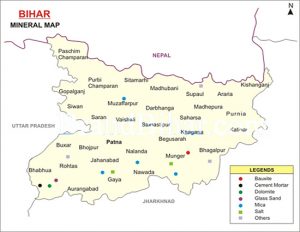Bihar Minerals
Introduction
The mineral base of this state is very rich. Particularly the Chotanagpur plateau is very mineral rich field. It has an extensive and high quality coal deposits. Iron ore and copper ore are also produced in Bihar. Bauxite, ore for aluminiumis also found here. This state has a reserve of pyrites and mica. The other important mineral resources found in Bihar are – limestone, graphite, chromite, manganese, nickel, barytes, kyanite and sillimanite, bentonite etc.
Bihar is a producer of Steatite (945 tonnes), Pyrites (9,539 tonnes/year), Quartzite (14,865 tonnes/year), Crude Mica (53 tonnes/year), Limestone (4,78,000tonnes/year).
Bihar is the principal holder of country’s pyrite resources and possesses 95% of resources. Bihar has also some good resource of Bauxite in Jamui district, Cement Mortar in Bhabhua, , Mica in Muzaffarpur, Nawada, Jamui, Gaya and salt in Gaya and Jamui.
Mineral Distribution in Bihar
Important mineral occurrences in Bihar are:
- Limestonein Kaimur (Bhabhua), Munger and Rohtas districts;
- Micain Nawada and Muzaffarpur district; quartz/silica sand in Bhagalpur, Jamui, Munger and Nalanda districts;
- Dolomite in Bhabhua
- Quartzite and talc/steatite in Munger district.
- Bauxite occurs in Munger and Rohtas districts;

- China clay in Bhagalpur and Munger districts;
- Glass sand in Bhabhua
- Feldspar in Gaya, Jamui and Munger districts;
- Fireclay in Bhagalpur and Purnea districts;
- Gold in Jamui district;
- Granite in Bhagalpur, Gaya, Jahanabad and Jamui districts;
- Iron ore (hematite) in Bhagalpur district:
- Iron ore (magnetite) in Gaya district;
- lead-zinc in Banka and Rohtas districts and
- Pyrite in Rohtas district.
Major Minerals
Now, we will
discuss about major minerals of Bihar one by one here:Steatite:
Steatite(soapstone) is a powder schist, which is a kind of changeable shake. It is largely made out of the mineral powder and is in this way rich in magnesium. It is delivered by dynamo thermal transformative nature and metasomatism, which happens in the zones where structural plates are subducted, changing rocks by warmth and weight, with inundation of liquids, yet without liquefying. It has been a medium for cutting for a great many years.
Pyrites
Pyrite is typically discovered related with different sulfides or oxides in quartz veins, sedimentary shake, and changeable shake, and additionally in coal overnight boardinghouses a substitution mineral in fossils. Notwithstanding being nicknamed trick’s gold, pyrite is here and there found in relationship with little amounts of gold. Gold and arsenic happen as a coupled substitution in the pyrite structure.
The mineral pyrite, or iron pyrite, otherwise called trick’s gold, is an iron sulfide with the concoction recipe FeS2. Pyrite is viewed as the most widely recognized of the sulfide minerals.
In Bihar it is mostly found in Rohtas district. Bihar has monopoly in the reserve and exploration of pyrite in India.
Quartzite
Quartzite is a hard, non-foliated transformative shake which was initially unadulterated quartz sandstone. Sandstone is changed over into quartzite through warming and weight normally identified with structural pressure inside orogenic belts. Unadulterated quartzite is typically white to dark, however quartzites regularly happen in different shades of pink and red because of changing measures of iron oxide (Fe2O3).
Quartzite is extremely impervious to compound weathering and frequently frames edges and safe peaks. The almost unadulterated silica substance of the stone gives little to soil; hence, the quartzite edges are regularly exposed or secured just with a thin layer of soil and little vegetation.
Atomic minerals of Bihar
Many atomic minerals may be found according to various studies done by geologist.
These minerals are said to be located in the mica belt of state. Major atomic minerals includes :
- Beryl
- Lithium
- Cesium and Rubidium
- Uranium
Minerals authority of Bihar
Amid 1964, Govt. of Bihar made a different and free division called Mines and Geology to take into account exercises identified with mining in view of accessibility of minerals over the state. Around then, there were two wings named as Mining and Minerals were operational under it. Later on as the duties expanded alongside volume of work, two directorates called Directorate
of Mining and Directorate of Geology came in presence in 1971.
After redesign of the state in 2006, the division and its directorate were reconstituted. Directorate of Mining and the Directorate of Geology were united as Directorate of Mining and Geology. Nearby/local workplaces under the Directorate of Geology were discarded and in view of the income from minerals, workplaces at Divisional and District level were sorted out .